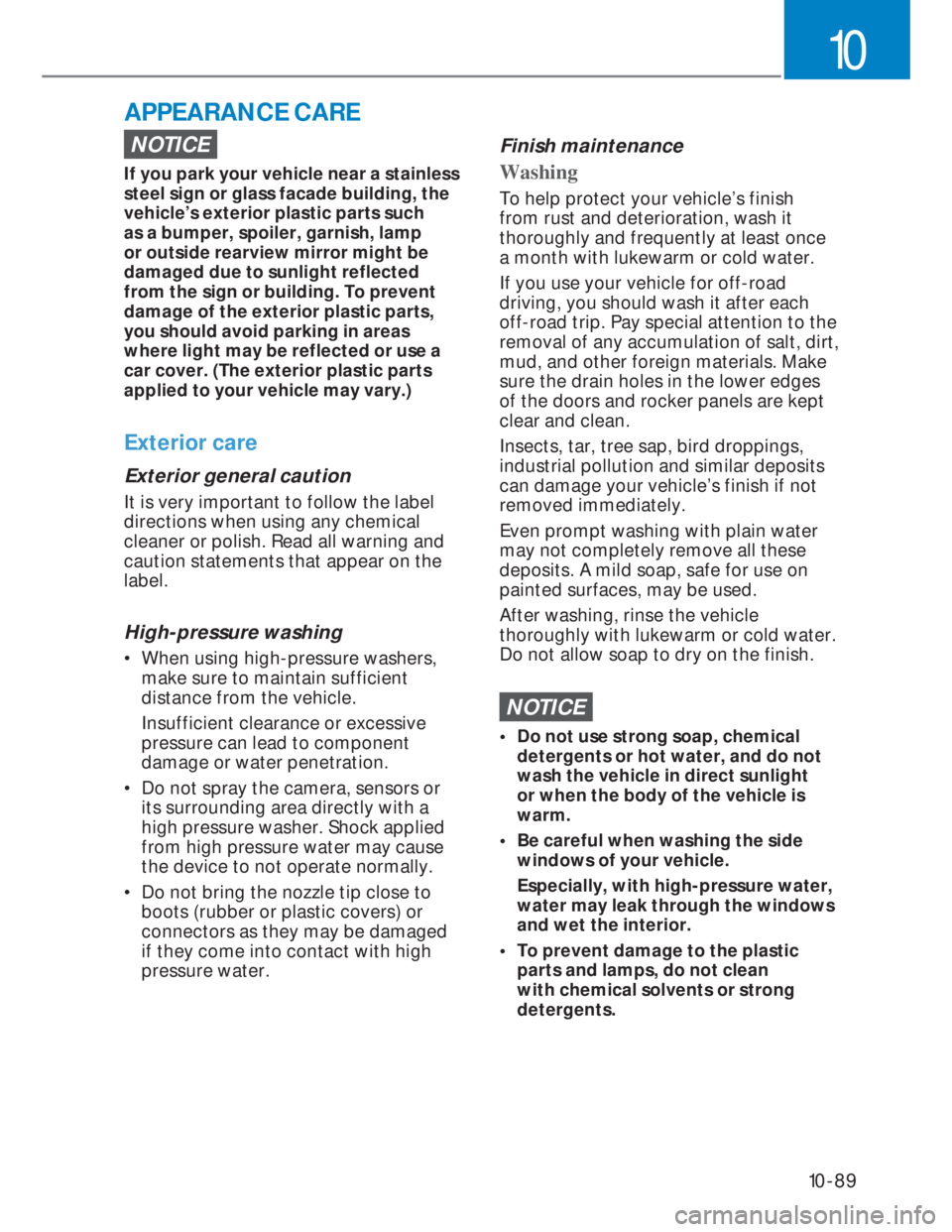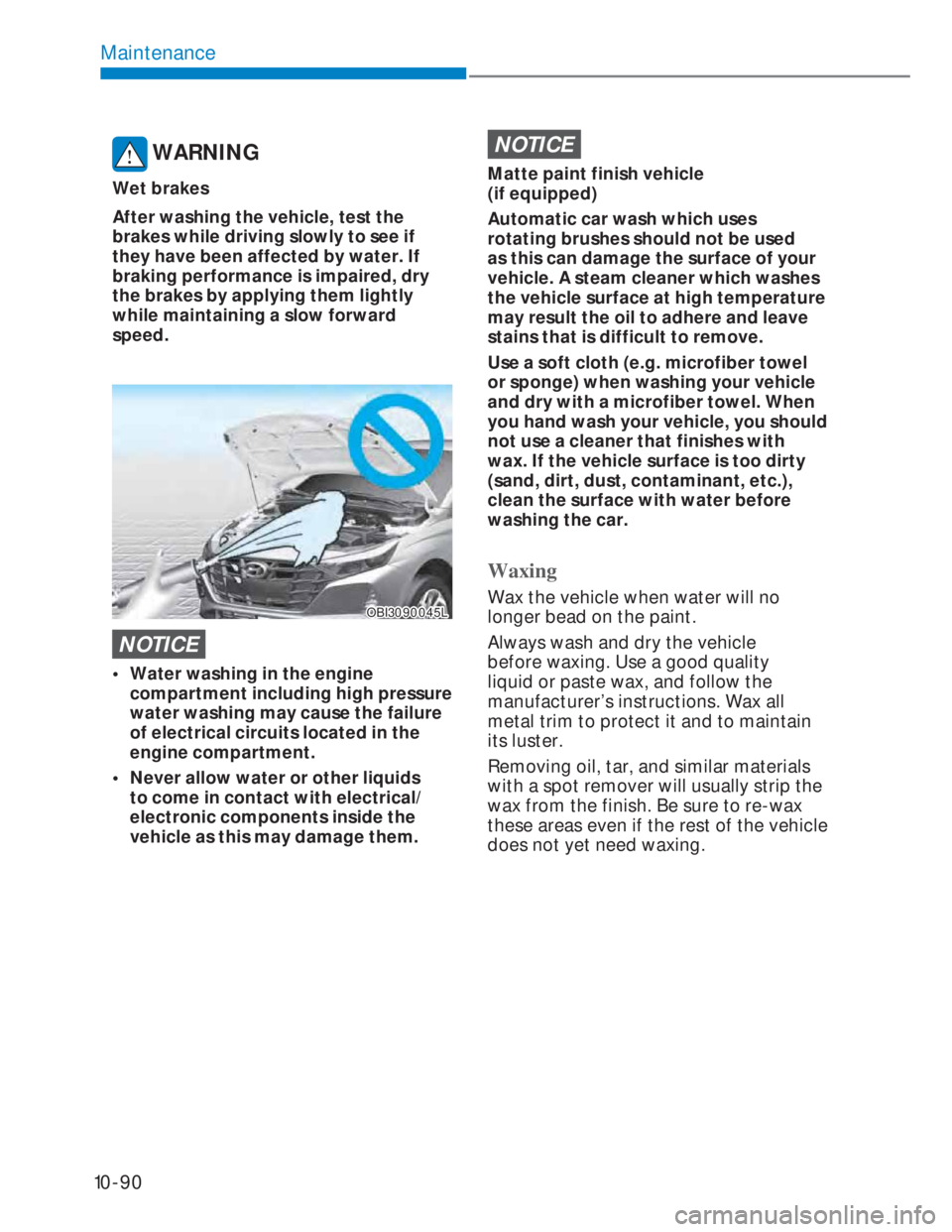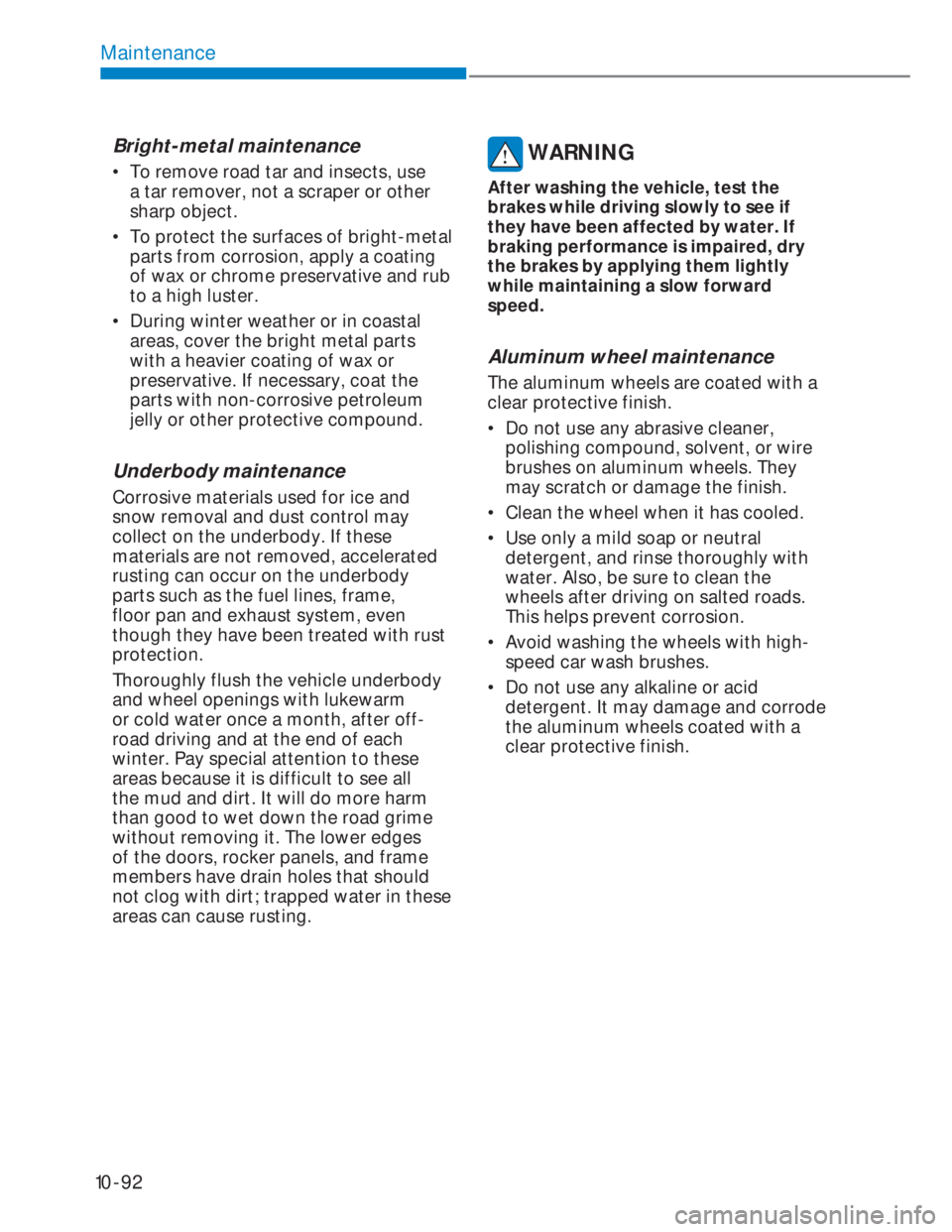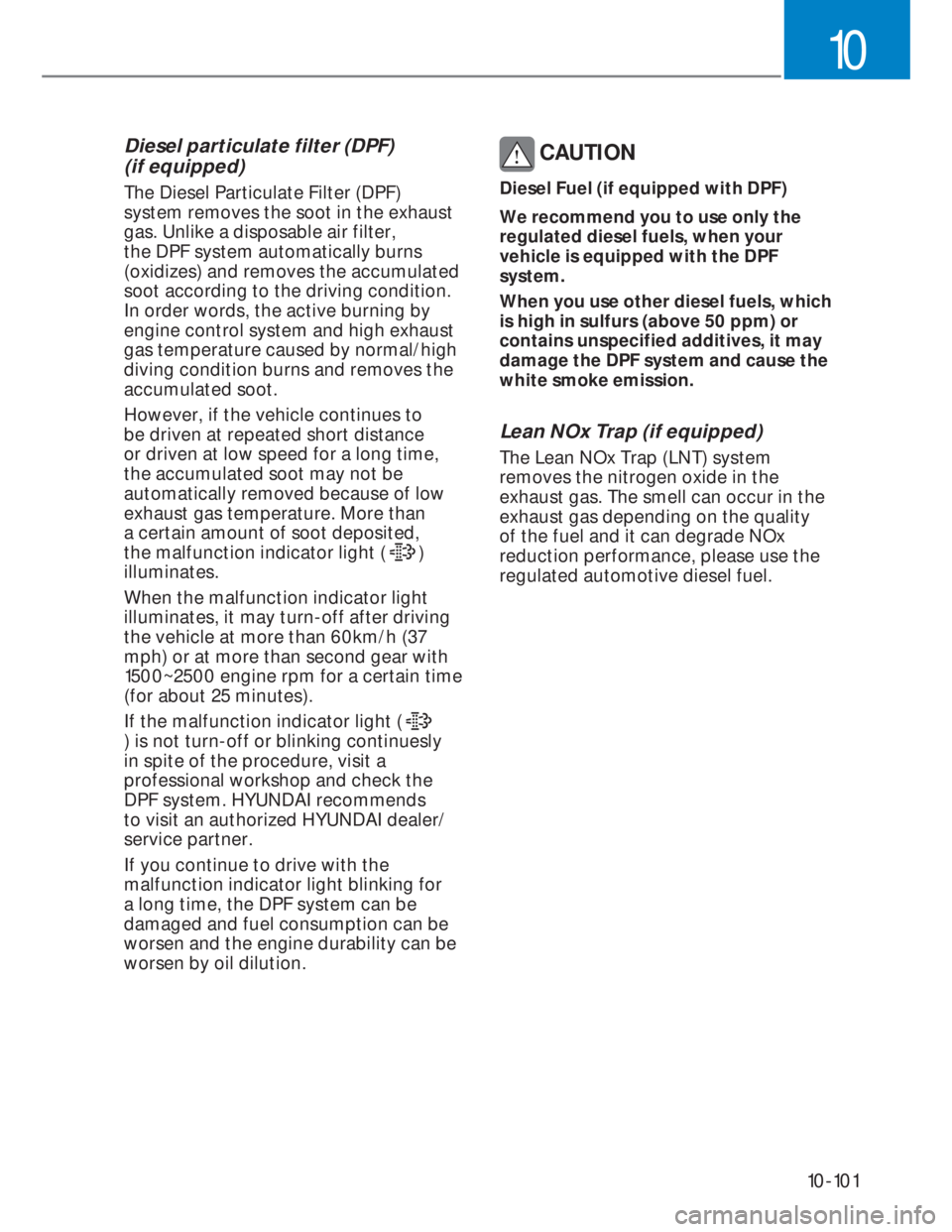light HYUNDAI I20 2021 Owners Manual
[x] Cancel search | Manufacturer: HYUNDAI, Model Year: 2021, Model line: I20, Model: HYUNDAI I20 2021Pages: 444, PDF Size: 8.93 MB
Page 428 of 444

10-89
10
NOTICE
If you park your vehicle near a stainless
steel sign or glass facade building, the
vehicle’s exterior plastic parts such
as a bumper, spoiler, garnish, lamp
or outside rearview mirror might be
damaged due to sunlight reflected
from the sign or building. To prevent
damage of the exterior plastic parts,
you should avoid parking in areas
where light may be reflected or use a
car cover. (The exterior plastic parts
applied to your vehicle may vary.)
Exterior care
Exterior general caution
It is very important to follow the label
directions when using any chemical
cleaner or polish. Read all warning and
caution statements that appear on the
label.
High-pressure washing
• When using high-pressure washers,
make sure to maintain sufficient
distance from the vehicle.
Insufficient clearance or excessive
pressure can lead to component
damage or water penetration.
• Do not spray the camera, sensors or
its surrounding area directly with a
high pressure washer. Shock applied
from high pressure water may cause
the device to not operate normally.
• Do not bring the nozzle tip close to
boots (rubber or plastic covers) or
connectors as they may be damaged
if they come into contact with high
pressure water.
Finish maintenance
Washing
To help protect your vehicle’s finish
from rust and deterioration, wash it
thoroughly and frequently at least once
a month with lukewarm or cold water.
If you use your vehicle for off-road
driving, you should wash it after each
off-road trip. Pay special attention to the
removal of any accumulation of salt, dirt,
mud, and other foreign materials. Make
sure the drain holes in the lower edges
of the doors and rocker panels are kept
clear and clean.
Insects, tar, tree sap, bird droppings,
industrial pollution and similar deposits
can damage your vehicle’s finish if not
removed immediately.
Even prompt washing with plain water
may not completely remove all these
deposits. A mild soap, safe for use on
painted surfaces, may be used.
After washing, rinse the vehicle
thoroughly with lukewarm or cold water.
Do not allow soap to dry on the finish.
NOTICE
• Do not use strong soap, chemical
detergents or hot water, and do not
wash the vehicle in direct sunlight
or when the body of the vehicle is
warm.
• Be careful when washing the side
windows of your vehicle.
Especially, with high-pressure water,
water may leak through the windows
and wet the interior.
• To prevent damage to the plastic
parts and lamps, do not clean
with chemical solvents or strong
detergents.
APPEARANCE CARE
Page 429 of 444

10-90
Maintenance
WARNING
Wet brakes
After washing the vehicle, test the
brakes while driving slowly to see if
they have been affected by water. If
braking performance is impaired, dry
the brakes by applying them lightly
while maintaining a slow forward
speed.
OBI3090045LOBI3090045L
NOTICE
• Water washing in the engine
compartment including high pressure
water washing may cause the failure
of electrical circuits located in the
engine compartment.
• Never allow water or other liquids
to come in contact with electrical/
electronic components inside the
vehicle as this may damage them.
NOTICE
Matte paint finish vehicle
(if equipped)
Automatic car wash which uses
rotating brushes should not be used
as this can damage the surface of your
vehicle. A steam cleaner which washes
the vehicle surface at high temperature
may result the oil to adhere and leave
stains that is difficult to remove.
Use a soft cloth (e.g. microfiber towel
or sponge) when washing your vehicle
and dry with a microfiber towel. When
you hand wash your vehicle, you should
not use a cleaner that finishes with
wax. If the vehicle surface is too dirty
(sand, dirt, dust, contaminant, etc.),
clean the surface with water before
washing the car.
Waxing
Wax the vehicle when water will no
longer bead on the paint.
Always wash and dry the vehicle
before waxing. Use a good quality
liquid or paste wax, and follow the
manufacturer’s instructions. Wax all
metal trim to protect it and to maintain
its luster.
Removing oil, tar, and similar materials
with a spot remover will usually strip the
wax from the finish. Be sure to re-wax
these areas even if the rest of the vehicle
does not yet need waxing.
Page 431 of 444

10-92
Maintenance
Bright-metal maintenance
• To remove road tar and insects, use
a tar remover, not a scraper or other
sharp object.
• To protect the surfaces of bright-metal
parts from corrosion, apply a coating
of wax or chrome preservative and rub
to a high luster.
• During winter weather or in coastal
areas, cover the bright metal parts
with a heavier coating of wax or
preservative. If necessary, coat the
parts with non-corrosive petroleum
jelly or other protective compound.
Underbody maintenance
Corrosive materials used for ice and
snow removal and dust control may
collect on the underbody. If these
materials are not removed, accelerated
rusting can occur on the underbody
parts such as the fuel lines, frame,
floor pan and exhaust system, even
though they have been treated with rust
protection.
Thoroughly flush the vehicle underbody
and wheel openings with lukewarm
or cold water once a month, after off-
road driving and at the end of each
winter. Pay special attention to these
areas because it is difficult to see all
the mud and dirt. It will do more harm
than good to wet down the road grime
without removing it. The lower edges
of the doors, rocker panels, and frame
members have drain holes that should
not clog with dirt; trapped water in these
areas can cause rusting.
WARNING
After washing the vehicle, test the
brakes while driving slowly to see if
they have been affected by water. If
braking performance is impaired, dry
the brakes by applying them lightly
while maintaining a slow forward
speed.
Aluminum wheel maintenance
The aluminum wheels are coated with a
clear protective finish.
• Do not use any abrasive cleaner,
polishing compound, solvent, or wire
brushes on aluminum wheels. They
may scratch or damage the finish.
• Clean the wheel when it has cooled.
• Use only a mild soap or neutral
detergent, and rinse thoroughly with
water. Also, be sure to clean the
wheels after driving on salted roads.
This helps prevent corrosion.
• Avoid washing the wheels with high-
speed car wash brushes.
• Do not use any alkaline or acid
detergent. It may damage and corrode
the aluminum wheels coated with a
clear protective finish.
Page 435 of 444

10-96
Maintenance
Leather (if equipped)
• Feature of Seat Leather
- Leather is made from the outer skin
of an animal, which goes through a
special process to be available for
use. Since it is a natural object, each
part differs in thickness or density.
Wrinkles may appear as a natural
result of stretching and shrinking
depending on the temperature and
humidity.
- The seat is made of stretchable
fabric to improve comfort.
- The parts contacting the body are
curved and the side supporting
area is high which provides driving
comfort and stability.
- Wrinkles may appear naturally
from usage. It is not a fault of the
products.
CAUTION
• Wrinkles or abrasions which appear
naturally from usage are not covered
by warranty.
• Belts with metallic accessories,
zippers or keys inside the back
pocket may damage the seat fabric.
• Make sure not to wet the seat. It may
change the nature of natural leather.
• Jeans or clothes which could bleach
may contaminate the surface of the
seat covering fabric.• Caring for the leather seats
- Vacuum the seat periodically to
remove dust and sand on the seat. It
will prevent abrasion or damage of
the leather and maintain its quality.
- Wipe the natural leather seat cover
often with dry or soft cloth.
- Use of proper leather protective may
prevent abrasion of the cover and
helps maintain the color. Be sure to
read the instructions and consult a
specialist when using leather coating
or protective agent.
- Light colored (beige, cream beige)
leather is easily contaminated and
the stain is noticeable. Clean the
seats frequently.
- Avoid wiping with wet cloth. It may
cause the surface to crack.
Page 440 of 444

10-101
10
Diesel particulate filter (DPF)
(if equipped)
The Diesel Particulate Filter (DPF)
system removes the soot in the exhaust
gas. Unlike a disposable air filter,
the DPF system automatically burns
(oxidizes) and removes the accumulated
soot according to the driving condition.
In order words, the active burning by
engine control system and high exhaust
gas temperature caused by normal/high
diving condition burns and removes the
accumulated soot.
However, if the vehicle continues to
be driven at repeated short distance
or driven at low speed for a long time,
the accumulated soot may not be
automatically removed because of low
exhaust gas temperature. More than
a certain amount of soot deposited,
the malfunction indicator light (
)
illuminates.
When the malfunction indicator light
illuminates, it may turn-off after driving
the vehicle at more than 60km/h (37
mph) or at more than second gear with
1500~2500 engine rpm for a certain time
(for about 25 minutes).
If the malfunction indicator light (
) is not turn-off or blinking continuesly
in spite of the procedure, visit a
professional workshop and check the
DPF system. HYUNDAI recommends
to visit an authorized HYUNDAI dealer/
service partner.
If you continue to drive with the
malfunction indicator light blinking for
a long time, the DPF system can be
damaged and fuel consumption can be
worsen and the engine durability can be
worsen by oil dilution.
CAUTION
Diesel Fuel (if equipped with DPF)
We recommend you to use only the
regulated diesel fuels, when your
vehicle is equipped with the DPF
system.
When you use other diesel fuels, which
is high in sulfurs (above 50 ppm) or
contains unspecified additives, it may
damage the DPF system and cause the
white smoke emission.
Lean NOx Trap (if equipped)
The Lean NOx Trap (LNT) system
removes the nitrogen oxide in the
exhaust gas. The smell can occur in the
exhaust gas depending on the quality
of the fuel and it can degrade NOx
reduction performance, please use the
regulated automotive diesel fuel.